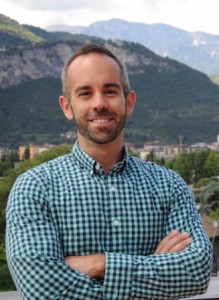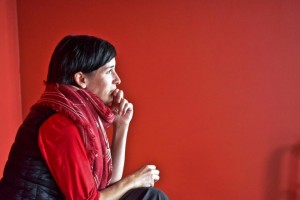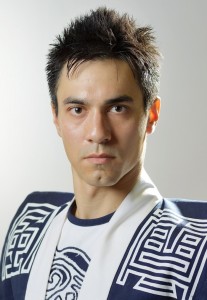|
The Swarthmore College Department of Music and Dance welcomes three new faculty members: Professor James J. Blasina, Professor Stephanie Liapis, and Professor Joe Small.
Professor Blasina is originally from Vancouver, British Columbia, and he has been interested in music since he was a child. His studies with his mentors, Professor Jennifer Bain and Jacqueline War at Dalhousie University, led him to a MA-PhD program at Harvard University, where he wrote his PhD dissertation on the way that music for St. Katherine of Alexandria modeled and mirrored changing conceptions of gender during the 12th and 13th centuries. “In many respects, I see this period as a point of origin for many of the gender systems that have held sway until the twentieth century,” Professor Blasina said. “I see music as an important primary source for illuminating these changes in the ways people were thinking about gender, and on the flip side, looking at music through this particular lens helps us understand [music] better.” Professor Blasina came to know a Swarthmore alum during his time in graduate school. “I was always so impressed by her well-rounded and critical ways of thinking about problems, and by her confidence and willingness to voice her opinions,” Professor Blasina said. “I was so excited when a position was posted in the Music and Dance Department, and I am grateful to be able to contribute to the work of this community of scholars and students.” Last semester, Professor Blasina taught Music 11, a music theory class that focuses on counterpoint, harmony, and musical form. This semester, he is teaching Music 28 (Sound, Sinners, and Saints in Medieval England), a course that considers what sorts of meanings human beings ascribe to sounds and music. He is also teaching Music 1a (1000 Years of Musical Firsts), which focuses on twelve significant musical premiere performances as important artistic and historical moments. Professor Blasina hopes that his students will have two takeaways from his classes. “First of all, in a one-semester course, even on a very focused topic, it’s impossible to cover everything that you’d like to,” Professor Blasina said. Using an analogy from his PhD advisor, Thomas Forrest Kelly, Professor Blasina believes that the big ideas in music history courses are like a row of telephone poles. He and his students will build the “poles” together in the course. “They should be sturdy and will hopefully entice students to fill in the gaps between the poles with ‘wires’ throughout their lives,” Professor Blasina said. The second takeaway is empathy. “It’s too easy to think of people in the distant past with simplifying and dehumanizing tropes,” Professor Blasina said. “But maybe through the classroom experience and by understanding their artistic expressions, we can come to appreciate and feel connected to the human beings—as human beings—who came before us, and by extension, better understand ourselves and our societies.”
Professor Liapis has had a professional career in the performing arts that spans over twenty years. She received a B.F.A. from NYU Tisch School of the Arts and an M.F.A. from the University of Washington. Professor Liapis’s choreographic research focuses on creating and presenting original, collaborative works that often weave in elements of digital sound and video to create a complete visual and sonic experience on stage . Professor Liapis began teaching at Swarthmore College because she was drawn to the diverse dance curriculum offered at the college. “It feels relevant, exciting, and progressive to offer training and education in so many movement forms,” Professor Liapis said. Currently Professor Liapis is teaching Modern dance technique, as well as yoga and dance composition. In these courses, Professor Liapis aims to provide students with opportunities for growth and creative freedom. “In my first semester, I am hoping to build trust with the students,” Professor Liapis said. “I want to provide a safe and exciting learning environment so that the studio becomes an active space for movement experimentation and exploration.” “I have been very impressed with the students’ curiosity and willingness to try,” Professor Liapis continued. “The students at Swarthmore are so motivated and engaged which allows us to really explore our material, it’s origin, it’s path, it’s purpose.” Currently, Professor Liapis is amidst a very exciting time in the dance program. “There is so much energy and momentum that will allow us to be more visible on the Swarthmore campus,” Professor Liapis said. “We are adding courses, developing curriculum, and offering new opportunities for students to work directly with professional choreographers!”
|
Touring the Mariner East 2 Pipeline
Twenty-five students from the Peace and Conflict Studies / Environmental Studies course “Climate Disruption, Conflict, and Peacemaking” braved cold temperatures to tour the route of the Mariner East 2 pipeline (ME2) that runs near Swarthmore College.
The ME2 will carry compressed propane, ethane, and butane from fracking operations in the Marcellus shale fields of western Pennsylvania to the port of Marcus Hook where these byproducts of natural gas production will be shipped mostly to Europe for the production of plastics.
The ME2 pipeline carries highly flammable liquefied gases under pressure through populated suburban neighborhoods, often only feet from homes, schools, residential facilities, detention facilities, and businesses. The pipeline has generated significant and growing local opposition and has raised questions about risk and regulatory processes. The gases are odorless, invisible, and heavier than air, raising concerns about the possibility of evacuation in the event of a leak.
Our tour took us to Marcus Hook and its refineries, an elementary school near a valve station, and Hershey’s Mill Village, a large retirement community in the potential blast zone of the pipeline. We met with local residents and activists at the latter two sites. We are immensely grateful to our guide, George Alexander, author of the Dragonpipe Diary, where you can find more investigative work on the pipeline and local campaigns to stop or regulate the pipeline.
For information from Sunoco on the pipeline, visit their website.
A new film Half-Mile, Upwind, On Foot, about resistance to the Atlantic Sunrise Pipeline (that we toured last year) and the Mariner East 2 pipeline, will be released soon.
Half-Mile, Upwind, On Foot trailer from Brian McDermott on Vimeo.
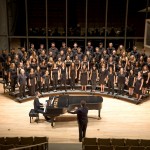
From Boulanger to Bernstein, College Chorus and Garnet Singers Celebrate Centennials
On Saturday, December 8th, at 3:00 pm in the Lang Concert Hall, the Swarthmore College Chorus and Garnet Singers, directed by Joseph Gregorio, will perform their fall concert. The Swarthmore College Chorus is a mixed ensemble comprised mostly of students, but is also open to faculty, staff, and community members. The Garnet Singers is a subset of the Chorus, composed of approximately twenty-four students, focused on works more intimate than those sung by the Chorus.
The Garnet Singers will be performing works in some way connected with the year 1918, and the Chorus will perform pieces by Leonard Bernstein. “1918 turns out to have been a significant year in music history as well as in world history,” Gregorio said.
Gregorio has always wanted to program Bernstein’s Chichester Psalms with the Chorus. Since it is the centenary of Bernstein’s birth, it seemed like the perfect timing to have such a program. In addition to Chichester Psalms, Gregorio chose to incorporate a few songs from West Side Story. “To represent Bernstein’s oeuvre more fully, I thought it would be nice to round out Chorus’s program with a few songs from West Side Story, which has some interesting musical connections toChichester Psalms,” Gregorio said.
Gregorio also notes that coincidentally, 1918 was the year of the death of three magnificent composers: Lili Boulanger, Claude Debussy, and Charles Hubert Hastings Parry. To further explore the theme and significance of 1918, the Garnet Singers will be performing a set that includes one work by each of these composers. Additionally, several other pieces will be included in the performance that have roots in the events of 1918.
This fall concert will also feature an original work by Lili Tobias ‘19. “The ensemble is especially excited to perform the premiere of Tobias’s piece, which Tobias wrote for us as a musical reflection on Lili Boulanger’s song ‘Reflets,’” Gregorio said.
Another student, Deondre Jordan ’19, will conduct the performance of Stephen Chatman’s In Flanders Fields.
Over the last five and a half years, the Chorus has doubled in size, presenting a continual challenge for Gregorio as well as the members of the group. Everyone must adapt to the current size of the group in order to continue making music at a high level. “Both ensembles, along with student pianist Mia Shoquist ’21, have worked tremendously hard to prepare for our December 8 concert,” Gregorio said. “The Garnet Singers have not only put in a great deal of musical work, but have also given generously of their psychological energy to bring to life music that is sometimes emotionally taxing to sing.”
“As ever, I am coming to the end of the semester with immense gratitude toward all of the musicians in our choral ensembles for all they have shared of themselves to make the concert a success,” Gregorio concluded.
David Chan ’19

Profile of Dance Major Zara Williams-Nicholas ’19
Zara Williams-Nicholas ‘19 is an international student from Jamaica, majoring in mathematics and dance at Swarthmore College. Williams-Nicholas started dancing when she was living in Jamaica, beginning ballet classes at the age of two. However, after moving to Massachusetts for high school, she was forced to stop taking dance classes due to financial obstacles.
Williams-Nicholas did not initially consider majoring in dance since dance is not usually associated with economic stability. “I was thinking I had to have a major that would help support me financially,” Williams-Nicholas said. “I chose math because the analysis of structures really interested me.”
Remarkably, it was mathematics that led Williams-Nicholas back to her interest in dance. “It was later on that I realized that the analysis of geometric and other structures could be applied to movement creation as well,” Williams-Nicholas said.
In her junior year, Williams-Nicholas took classes in improvisation and contemporary dance. Because of her experiences in those classes, she reconnected with dance and began identifying strongly as a dancer. “I felt as if I had found dance styles that really resonated with me as an artist in contemporary dance class,” Williams-Nicholas said. “As for improvisation, I began using dance as a framework for everyday life, exploring movement practices and creation even outside of class.
Through dance, Williams-Nicholas has been able to challenge herself, especially since she had to complete most of the major in one year. “I sometimes feel physically fatigued, but my love for what I do pushes me forward,” Williams-Nicholas said.
Furthermore, Williams-Nicholas uses dance as a conduit for self-love. “It is an art form that lets you communicate with the world in a way that I personally find very pleasing,” Williams-Nicholas said. “It is also a process wherein you can really begin to love your body for what it can do, and where you can get out of the habit of disliking the look of your body.”
For Williams-Nicholas, dance is not just about mastering the technical aspects—it is also about discovering how your body moves through space. “You become aware of small movements and tendencies in your body that you may not have been aware of beforehand,” Williams-Nicholas said. “You can create movement that is unique to your body and that tells a story that you want to tell.”
“I have learned bodily awareness for myself and for others, and I have learned about the idea of consent while partnering or doing group work,” Williams-Nicholas continued.
Before coming to Swarthmore, Williams-Nicholas choreographed an original piece at her old school in Jamaica. She attributes that performance as one of the happiest times of her life. At Swarthmore, she has choreographed a piece in response to Thomas DeFrantz’s visit to her contemporary dance class. “The piece focused on blackness in dance and how that tends to be received,” Williams-Nicholas said.
Currently, Williams-Nicholas has many projects in progress. For the upcoming Fall Dance Concert, she is working on Professor Stephanie Liapis’s modern dance piece and on Professor LaDeva Davis’s tap dance piece. Additionally, Williams-Nicholas is a part of student dance group Terpsichore, working on a piece about her personal life, which she hopes to reflect through movement. She recently joined Rhythm and Motion, a tri-co student dance group, and is working on various pieces for that group, as well.
After graduation, Williams-Nicholas hopes to continue dancing. “I hope to use both my majors after graduation, doing some combination of problem-solving and movement for the rest of my life” Williams-Nicholas said. “I want to be financially stable, I want the ability to dance onstage and to choreograph, and I want to continue to develop my dance practice in a safe way so that I can dance for as long as possible.”
David Chan ‘19
Infographic Session – Climate Disruption course
Please join the students in Climate Disruption, Conflict, and Peacemaking (PEAC 055 / ENVS 031) for an infographic session (similar to a poster session) on Monday morning December 10 at 10:30 a.m. in Shane Student Lounge.
Refreshments provided. This is a zero waste event.
With thanks for support from the Lang Center for Civic and Social Responsibility
Anti-Blackness as Latin American Nationalism
Anti-Blackness as Latin American Nationalism
Time/Location: Monday, December 3rd from 4:30pm-5:30pm in the IC Dome (Sproul 201)
Description: You are all invited to Zahira Kelly-Cabrera’s talk on Anti-Blackness as Latin American Nationalism. Zahira Kelly-Cabrera aka @Bad_Dominicana is an AfroDominicana mami, writer, artist, mujerista, award-winning sociocultural critic, and international speaker. She is known for advocating for LatiNegra visibility and rights on social media, and unfiltered social critique, broken down in accessible language. She also aims to pick apart white supremacist capitalist hetero-patriarchy from an anticolonial AfroLatina perspective. The talk is open to the public.
Sponsors: The President’s Office, The Black Cultural Center, The Women’s Resource Center, The Office of Diversity, Inclusion and Community Development, Spanish Department, The Intercultural Center, Sociology & Anthropology Department, ENLACE, SASS, SOCA, Peace & Conflict Studies Department, Black Studies Program, Latin American & Latino Studies Program, The Interfaith Center, Educational Studies Program, and Religion Department.
CIL@SF trip to meet Swarthmore alums in Silicon Valley
Since 2015, the CIL has organized CIL@ SF, a trip for approximately 10 students to meet Swarthmore alums and tour tech related companies in the San Francisco and Silicon Valley areas. Students have had the opportunity to meet with entrepreneurial alumni who live and work in the region, to learn about their work and their workplaces, and engage with start-up, venture capital, and tech communities. In January 2018, CIL@ SF visited parents, alumni, and colleagues at Google HQ, Ancestry.com, Title Nine, DFJ Ventures, Stitch Fix, OpenTable, and Stanford University’s d.school.
This year the CIL@ SF trip has been redesigned to align more closely with current classes being taught in Swarthmore, and in 2019 will be delivered as a supplement course to PEAC049: Be the Change! Social Entrepreneurship Principles in Practice, delivered by Denise Crossan, Lang Visiting Professor for Issues of Social Change.
The CIL@ SF trip and supplement course is delivered as an engaged scholarship class. Preparatory classes and in-depth learning experiences combine to give students the opportunity to explore, examine and reflect on theory in practice. The required class preparation will consist of 4 classes of 2 hours duration delivered prior to Spring Break 2019. Students will be required to work in teams and individually to write short reflective reports on the learning experience throughout the course. PEAC049A is for zero credit as it is a supplement to PEAC049 for Spring Semester 2019.
CIL@ SF 2019 Learning Goals:
- Through case studies, examine a number of society’s “wicked problems”. Explore the range of contributing issues to wicked problems and the methods employed to find solutions to seemly intractable issues.
- Understand and explore the principles of social innovation as applied in a number of different scenarios.
- Examine the knowledge base, experience and career paths of individuals who are social innovators across the public to private spectrum.
Who: 10 Swarthmore students
Where: Start-up, venture capital, and tech communities with a social entrepreneurship or innovation focus + more in San Francisco and Silicon Valley
When: March 10-16, 2019
Cost: $0. All travel, food, and accommodations are covered by the CIL
How to Apply
Registration for this supplemental class will be through a written online application and a short interview. Please note that this supplemental course is open to all students. While students enrolled in “PEAC049: Be the change! Principles in Practice” are encouraged to apply, it is not compulsory as part of the PEAC049 requirement, nor will places be reserved. To apply, students will be asked to submit:
- A current resume (PDF)
- An essay, no longer than 1,000 words, (PDF) answering the following questions
- What do you think you’ll gain from the CIL@ SF Trip?
- What would you most like to ask or learn from alumni working in social innovation and social entrepreneurship?
Applications will be reviewed by a CIL panel, and on first round selection based on the essay, students will be asked to attend a short interview. Only 10 students can go on the trip and must confirm that they are available and committed to travel on dates between March10-16, 2019 (Spring Break week). Please note that this supplemental course is open to all students. While students enrolled in “PEAC049: Be the change! Principles in Practice” are encouraged to apply, it is not compulsory as part of the PEAC049 requirement, nor will places be reserved.
Important Dates!
- An Information Session on CIL@ SF will be held: Tuesday, November 27th, 12:30pm in Shane Lounge
- Online applications should be submitted by: Friday November 30th by 11:59pm via Google Form above
- Interviews will take place: the weeks of December 3rd/10th, Social Innovation Lab
- Notification by: No later than December 17th
Please contact Katie Clark at kclark2 if you have any questions!
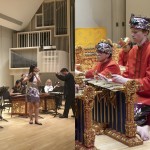
Gamelan and Chinese Music Ensemble Perform in Joint Concert
When asked what they hope students get out of participating in their respective music ensembles, Professors Lei Ouyang Bryant and Tom Whitman both make reference to communal music-making as a way to escape the numerous pressures experienced by a typical Swarthmore student. “I think it is great for Swatties to play music for two to four hours a week amidst the rest of their busy schedules,” says Bryant, co-director of the Chinese Music Ensemble (CME). Whitman, co-director of Gamelan Semara Santi (Gamelan), which plays music from Bali, Indonesia, puts it a bit more bluntly: “It is my hope that students find in Gamelan a place to rid themselves of the stress that is endemic at Swarthmore.”
Beyond just stress relief, though, Bryant and Whitman hope that their respective groups provide space for community members to either explore a different music culture or celebrate and recognize their own. Whitman runs Gamelan rehearsals “Indonesian style—without any notation, and with minimal talking or analysis. I’d like our sessions to create a safe space where students can learn about Balinese culture by doing, rather than by reading or talking.” For her part, Bryant sees the CME “as a valuable site on campus where Asian students, Asian American students, and students interested in Chinese culture can work together and find community with each other.”
Enthusiasm for such a community is evident in the fact that enrollment in CME has more than doubled in its first three semesters. The ensemble is open to all, although most of this semester’s 25 members came in with some musical training. However, few had experience with traditional Chinese instruments such the guzheng (zither), erhu (bowed fiddle), pipa (plucked lute), yangqin (hammered dulcimer) or dizi (flute). Bryant’s co-director Guowei Wang, a Shanghai-born erhu artist, arranges folk songs and more recent Chinese and Taiwanese compositions to tailor them to the specific skill levels and talents of the current crop of students. Bryant describes the CME as “so fortunate to have [Wang] co-directing the ensemble and developing repertoire that everyone, from beginner to advanced, can play within one semester of study.”
Gamelan is also open to students—and Swarthmore community members—regardless of musical background, and is perhaps slightly more accessible to newbies due to the percussive nature of its instruments, which consist of mostly bronze-keyed xylophones, gongs, and drums. But while hitting a gong might as a technical act be a bit easier than playing a fiddle, for example, the overall musical product is quite complicated, with each person playing an essential rhythmic role. Says senior Aly Ye, who has been a part of Gamelan for all of her four years at Swarthmore, “I love the complexity of the music and the challenge of learning it together, part by part, as an ensemble.” The tightly interwoven percussive parts result in a soundscape that is, according to Whitman, a “beautiful texture of different layers.”
Another non-sound layer is sometimes added to the mix when Gamelan pieces are accompanied by dance. Whitman explains that, “in Bali, dance and music are two facets of the same coin,” and that “while there are many pieces of instrumental music that do not accompany dance, all are informed by the spirit and many specific techniques from Balinese dance.” This close relationship has been evident to Ye, who will dance and play in the upcoming show. She says that “because the dance is so closely tied to the music, I feel like I’ve gained deeper insight into why the music moves and changes in the way that it does…. there are many times when something is emphasized in the music that, when I’m learning the dance, suddenly make more sense.” Whitman states that his lack of dance training is “one of my biggest weaknesses as a gamelan director. But we are extremely fortunate that our co-directors, I Nyoman Suadin and Latifah Alsegaf, come to campus. They bring to our ensemble that dimension of dance that I am not competent to teach.”
Audiences can come experience this auditory and visual feast in person on Sunday, December 2nd at 3pm, in the Chinese Music Ensemble and Gamelan Semara Santi’s combined end-of-semester concert. The performance will be held in Lang Concert Hall and is free and open to the public. Families are welcome!
Lydia Roe ’20
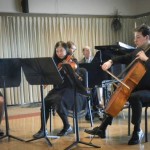
Opera, Jazz, Sonatas, and More Featured in Fetter Concerts
On Friday, November 30th at 8:00 pm in the Lang Concert Hall, the semester’s first concert of the Elizabeth Pollard Fetter Chamber Music Program will be held. The Department of Music and Dance has been supporting the Fetter Chamber Program for four decades, allowing student musicians to receive professional coaching. Students must audition in order to participate in the program. Student musicians are then divided into various groups that meet weekly for ten one-hour coached rehearsals, as well as a weekly one-hour self-directed rehearsal. This consistent rehearsal process culminates in a performance at the end of the semester.
Dr. Michael Johns is the current director of the Fetter Chamber Music Program. His role is to help set up the semester, put the programs together, pair groups with appropriate coaches, and monitor how the groups are progressing. In general, the selection of groups, performing partners, and repertoire are student-generated. “When someone expresses an interest in participating but does not have a partner, I help to build a group,” Dr. Johns said.
Although the Fetter Chamber Music Program was put in place to fund coaching for student musicians, the weekly self-directed rehearsal is what ultimately shapes the performance that the audience will see. “This is an important aspect because chamber music is a conversation among equals and members of the group must develop their own internal dialogue,” Dr. Johns said.
Eleven student groups will perform, including duos for flute/piano, violin/piano, two pianos, piano four-hands, and cello/piano; a piano/violin/cello trio; some late Middle Ages, gospel, and opera vocal selections; a jazz combo and an improvisation group. “As you can see it is an eclectic mix with, literally, something for everyone,” Dr. Johns said. “The concerts will span 700 years of musical history, from improv being conceived in the moment to works from the 14th century.”
This year’s preparation for the concert has been quite different than in previous years because some students expressed interest in mounting an opera.
“Preparing for the preview in this semester’s concert has been particularly unusual because we haven’t actually staged the opera yet,” Rebecca Regan ‘19 said. “We’ve had to be creative and put together a semi-staged performance, which communicates the theatricality of the piece in a way that’s presentable and dramatically effective, even in the absence of full blocking.”
Regan will be one of the six featured sopranos in The Audition, which is a one-act comedic opera conceived by Martha Collins. Collins wrote the libretto and arranged music that was originally composed by Franz von Suppé.
“The Audition is unequivocally an ensemble piece, but nevertheless as an opera it goes back and forth between choruses and solos/duets,” Regan said. “Hence, it required an extra degree of flexibility and independence in making sure to do the work we needed to do on our solo parts while working on the choruses together.”
“One lovely thing about this music — the opening number, ‘Audition Jitters,’ in particular — is that the six parts weave together in a number of different ways and each character interacts musically with multiple others,” Regan continued.
The other two pieces that will be performed in the concert had a more traditional preparation process. Berlin Chen ‘19 will be playing the violin in the Piano Trio in a Minor, which was composed by Joseph Maurice Ravel in 1914.
Piano Trio in a Minor follows the standard plan of a piano trio, with the first and fourth movements in sonata form surrounding a scherzo/trio and slow movement. The piece is dramatic in mood due to the many ebbs and flows, and to its large dynamic range.
“Ravel Trio is a tricky piece to play!” Chen said. “For example, there are places where the piano and the strings have different time signatures, so we had to count carefully to make sure we were playing together.”
“Also, the piece has many delicious chords and has interesting use of harmonics in the strings, so I think the performance will be colorful and refreshing.” Chen continued.
Because each semester’s rehearsals and concerts are all unique, student musicians who participate in the Fetter Chamber Music Program always have a chance to challenge themselves and grow.
“It is incredible to hear the amount of growth and maturation from the beginning of the semester to the performance,” Dr. Johns said. “Everyone, without exception, plays up to or exceeds their individual abilities and the students are justifiably proud of their accomplishment.”
Following the first concert on Friday, November 30th will be two more concerts. The second concert will be held on Sunday, December 2nd at 7:30, and the third will be held on Friday, December 7th at 8:00pm.
David Chan ’19

Profile of Dance Minor Ella Small ’19
Ella Small ‘19 is a physics major and dance minor at Swarthmore College. Initially Small did not consider minoring in dance, but she took dance classes at Swarthmore to have fun and to challenge herself.
“I did not think about minoring in dance until this year (my senior year) when I realized how close I was to finishing the minor, just because I kept taking dance classes for fun,” Small said. “I knew coming into Swat my freshman year that I wanted to explore dance, but I never could have guessed how engrossed I’ve become with the sport through the years.”
Prior to Swarthmore, Small did not have a dance background. She only began taking up dance, specifically ballet, to engage herself in a similar activity as gymnastics.“Before coming to Swat, I was a high-level competitive gymnast for 15 years, but I had never actually danced until taking Ballet I here with Professor Olivia Sabee,” Small said.
Because ballet was unfamiliar, Small found the dance form demanding, but ultimately rewarding because she was able to push past her boundaries. “Dance gives me an opportunity to challenge myself physically and mentally,” Small said. “Physically, because it is such a demanding sport, and mentally, because I’m a very shy person, and performing does not come naturally to me. Dance gives me the opportunity to be creative and push myself outside of my comfort zone,” Small continued.
Although Small did not possess previous knowledge about ballet, her transition into Swarthmore ballet classes happened smoothly due to the supportive nature of the Dance Program.“The professors in the Dance [Program] were so encouraging when I first started out, and they kept pushing me to take more challenging courses as I progressed,” Small said. “All of my teachers knew the perfect combination of pushing me to become a better dancer, while encouraging me and reminding me of the progress I’ve made.”
Small identifies one professor in particular whose classes were the most difficult for her. “Every class I take with Professor Chandra Moss-Thorne, I think about how those were [some] of the hardest dance classes I’ve ever taken, and I keep thinking that every week,” Small said.
As Small progressed in her dance classes, she learned much more than just technique. “Working my way from Ballet I to Ballet III and learning to dance en pointe, I’ve discovered so much about dance and performance, and also how my body moves in space,” Small said.
Small even took her dance outside of classes, and she joined the Swarthmore dance group Terpsichore during her sophomore year. By Small’s junior year, she began choreographing original pieces, which were performed in the combined Terpsichore/RnM (Rhythm ‘N Motion, a tri-co dance group) dance concert each semester.
“I remember a bit of a stunned silence after the first piece I choreographed went onstage, because the piece was so intense and unexpected, which encouraged me to keep choreographing for Terpsichore!” Small said.
This semester, Small is choreographing two pieces: a large group piece and an acrobatic piece drawing from her circus and gymnastics background for the upcoming Terpsichore/RnM dance concert on December 15th.
Currently, Small is finishing work for her physics major by taking electrodynamics. She is also amidst graduate school applications, applying to schools that offer a PhD in biomedical engineering. “After Swat, I’m hoping to receive a PhD using both my physics and dance knowledge to study human motion and biomechanics, with the eventual goal of perfecting human-robotic interfaces to help people who have lost mobility through stroke or accident move again,” Small concluded.
